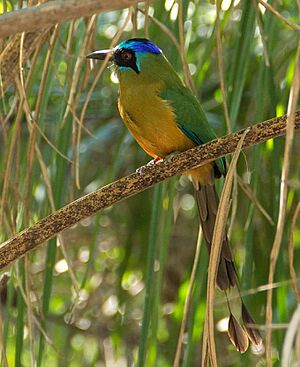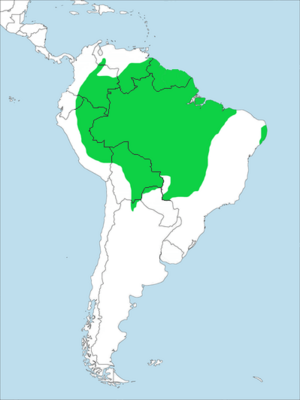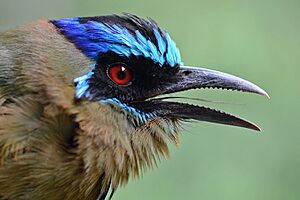Amazonian motmot facts for kids
Quick facts for kids Amazonian motmot |
|
|---|---|
 |
|
| Conservation status | |
| Scientific classification | |
 |
|
| Range | |
| Synonyms | |
|
Ramphastos momota Linnaeus, 1766 |
The Amazonian motmot (Momotus momota) is a super colorful bird. It belongs to the Momotidae family. You can find it in the lowlands of the Amazon rainforest. It also lives in the lower parts of the Andean mountains. Its home stretches from eastern Venezuela all the way to eastern Brazil and northeastern Argentina.
Contents
Meet the Motmot Family!
The Amazonian motmot is part of a bird family called Momotidae. It has many relatives, like the blue-capped motmot and the Andean motmot. For a long time, scientists thought these birds were all the same species. But now, they know they are different! The Amazonian motmot has nine different types, called subspecies. You can learn more about where they live below.
What Does an Amazonian Motmot Look Like?
The Amazonian motmot is a very striking bird! Its feathers are mostly green. But the exact colors can be a bit different depending on where the bird lives. All motmots have a very long tail. The two longest feathers at the end of the tail have bare shafts. Then, they suddenly widen into a "racquet" shape at the very tip. These tips can be green or black.
Most motmots have a black mask around their eyes. This mask can be big or small. The top of their head is usually black. This black cap is often surrounded by a bright blue band. Some motmots, like the one found in its main area, have a chestnut (reddish-brown) color on the back of their neck. Other types might have more chestnut on their neck and face.
Where Do Amazonian Motmots Live?
The Amazonian motmot lives across a huge area in South America. This is mostly to the east of the Andes mountains. There are nine different types, or subspecies, of this bird. Each type lives in a slightly different part of the region.
Here are the different places you can find them:
- Momotus momota momota: Lives in eastern Venezuela, Guyana, Suriname, French Guiana, and northern Brazil.
- M. m. microstephanus: Found in southeastern Colombia, eastern Ecuador, and northwestern Brazil.
- M. m. ignobilis: Makes its home in eastern Peru and western Brazil.
- M. m. nattereri: Lives in northeastern Bolivia.
- M. m. simplex: Found in western to west-central Brazil, south of the Amazon River.
- M. m. cametensis: Lives in north-central Brazil.
- M. m. parensis: Found in northeastern Brazil.
- M. m. marcgravianus: Lives in eastern Brazil.
- M. m. pilcomajensis: Found in southern Bolivia, southern Brazil, and northwestern Argentina.
These birds love to live inside humid lowland forests. They also hang out at the edges of these forests. You can find them at different heights depending on the country. For example, in Venezuela, they live up to about 1,200 meters (3,900 feet) high. In Ecuador, they go up to 1,000 meters (3,300 feet). In Peru, they are found up to 750 meters (2,500 feet) high.
How Do Amazonian Motmots Behave?
What Do They Eat?
The Amazonian motmot eats a mix of different things. It's an omnivore, which means it eats both plants and animals. They have been seen eating insects and other small creatures like spiders. They also eat small mammals and reptiles. And, of course, they love to munch on fruit!
How Do They Build Nests?
Like most birds in their group, Amazonian motmots build their nests in long tunnels. They dig these tunnels into earth banks, like riverbanks or hillsides. Scientists don't know much else about how they raise their young.
What Do They Sound Like?
The Amazonian motmot has a unique song. People describe it as a fast, hollow "hoo-do." It can also sound like a bubbling "whOOP-oo." Sometimes, they make a rough "kak" sound. They might even repeat this sound in a series.



